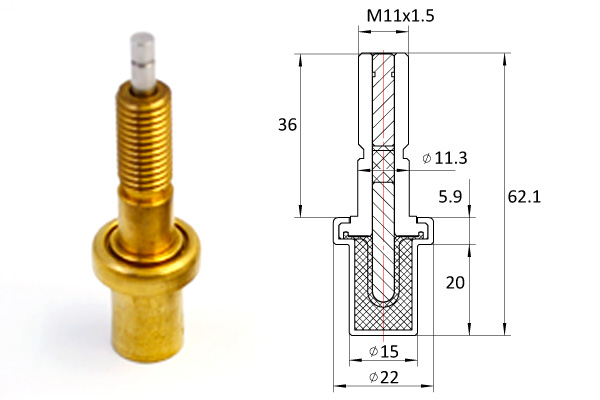The hardware is based on dual tone multi frequency (DTMF) and programmable logic device (CPLD). An elevator automatic monitoring and alarming system is developed, thermostatic element and the monitoring controller in the system is designed. The designed controller can monitor and alarm the parameters of the door switch, car lighting, safety clamp clamping force and traction speed of elevator equipment, and realize the monitoring by VHDL language programming. The control system has good flexibility and adaptability, and can be upgraded according to the actual conditions. The measured results of elevator show that the design scheme is basically feasible.

With the acceleration of China’s urbanization process, the demand for elevators has soared.
By 2012, the number of elevator lifts in China has reached nearly 2 million 400 thousand units. It is estimated that in the next 10 years, the average annual growth rate of elevator will exceed 20%. As the safety and comfort of elevators is related to public safety, the maintenance of elevators has always been the focus of the elevator industry. Regular inspection of maintenance and elevator inspection institutions has become the main way to ensure the safe operation of the elevator. Due to the large number of elevators and the lack of maintenance personnel, the management and technical level of each maintenance unit are uneven, elevator failures are difficult to detect in time, and effective measures are taken to monitor and monitor the operation parameters of the main equipment of the elevator. The subject that the employer and maintenance unit must deal with together.
At present, an elevator monitoring and alarming system has been developed abroad. Its main hardware is ASIC chip, and its price is very expensive. It is used in high-rise and high-speed elevators, but the system is not flexible. In the design of elevator monitoring and alarm controller, the main hardware adopts complex programmable logic device (CPLD) and dual tone multi frequency (DTMF). When the speed of tractor and tractor is abnormal, the system uses the telephone network system to send out the fault alarm signal by dialing. The system realizes the alarm control function by software programming, which has the characteristics of strong flexibility and simple structure. The overall structure of the alarm system is shown in Figure 1. Its main function is to monitor and identify the door switch, car lighting, safety clamp clamping force and the measured signal of the tractor speed. Multiple sensors are responsible for obtaining the signal parameters of different parts of the elevator equipment.
When the sensor detects the fault signal of the device, the system starts the DTMF to dial according to the classification of the identified abnormal signals. The work that the fault signal recognition controller needs to accomplish is as follows: (1) issuing pick-up/hang-up instructions; (2) identifying the working status of the circuit; (3) analyzing and processing the fault signal when the dial-up operation is effective. This paper focuses on the functional design of the fault alarm control area. The combination of hardware language description and function decomposition can ensure the efficiency and accuracy of the circuit design.

First, the total function of the system is decomposed into several functional modules. Then, the VHDL language is used to program the top module of the unit module.
At the same time, each module is detected and debugged and simulated. The failure alarm controller can be decomposed into the following unit functions. Module: control the module of hang up / off hook PICK, identify the module JUDGE of the telephone voice signal and the module RT receiving and sending the DTMF timing. The top level circuit is shown in Figure 2. The system clock (CLK) is used by three modules together, and the RESET pin is the system reset signal. When RESET is in an effective state, the PICK output state of the module is the signal on the hook. If the sensor detects that the signal is in the normal working state, the EN pin is displayed as At low level, PICK pin will also be displayed and output to low level. At this time, other modules and off-hook circuits are in the idle state of non-work.
When the signal detected by the sensor is in fault state, both pin EN and PICK display and output high level. The output signal of PICK will be transmitted to module RT. Module RT will generate call processing command and insert the command into MT8880 chip as a statement. Its original setting is changed to “call processing” mode. At this time, according to the real-time state of the telephone network, IRQ signals of different frequencies are output by MT8880 chip. The IRQ input port of JUDGE module will connect with the output signal of IRQ. After receiving the request signal IRQ by JUDGE module, IRQ will be counted by applying pulse to IRQ to determine whether the telephone voice is in the dial state or not, if the telephone voice is not located. In the dial tone state, the system generates a “busy” BUSY signal, which is fed back to the module PICK. When the PICK receives feedback, it immediately outputs the “hang-up” signal, and then hangs up the phone. At this time, the module JUDGE will re-judge IRQ. If the phone tone is in the dial tone state, the module JUDGE will immediately send the DIAL dial signal according to the instructions, and feedback the signal back to the module RT, so as to control the MT8880 chip.
The purpose is to enable it to automatically dial out pre-set telephone numbers. This paper only introduces the design of module JUDGE and module PICK. K output signal will change to “hang up” state. The working circuit of module JUDGE is shown in Figure 4.
Its main function is to recognize dial tone, ringback tone and busy tone. After MT8880 processing, these three voices are transformed into pulse signals with different frequencies. If a standard counting period is taken, the counting results will be totally different. In the process of module JUDGE recognition, two counters are used, one counts the output signal of MT8880. The other is used for timing. In the telephone network system, the source frequencies of the three sounds are 450 Hz ( 25 Hz) and the waveforms are sinusoidal. But what is advantageous to the recognition is that the intermittent ratios of each audio are different, and the obvious differences occur in the time interval, in which the dial tone is continuous, the busy tone is 0.35 s, and the ring tone is on-off for 1 s and off for 4 s. If the IRQ signal output from MT8880 is counted, the counting time is 5 seconds, and the range of dial tone counting is 2125-2375. Similarly, the range of busy tone counting is 1041-1212, the range of ringback tone counting is 425-475, and the counting of no signal should be 0. Using the same method, using a counter in the module JUDGE, the CLK clock signal is counted, which will generate another control signal in the module JUDGE. The counter will count the pulse transmitted by IRQ. When the pin PICK is in the off-hook signal, it must start two counters at the same time. After the counter starts for 5 seconds, the counting value of the second counter is recognized again. When judging busy tone and dial tone operation, the median value of 1668 is generally taken as the recognition criterion, which can reduce the counting error. Similarly, 858 will be used as the criterion of dial tone and ringback tone. Seconds later, if the counting result of the second counter exceeds 1668, the audio is a dial tone. If the counting value is between 858 and 1668, the audio is busy and the counting value is less than 858, the audio is a ringback tone. If the counting value is about zero, then the system is in a non-signal state. Conversely, if the counting value is more than 1668, the telephone network system must be in a dialable state and the pin DIAL is in a valid value “1” state, otherwise the pin BU is in a state. SY is in the invalid value “0” state, at this time, the module needs to be triggered again in order to carry out dialing operation. Programmable logic device FLEX10K10L-84 is used as the main hardware of the monitoring controller. Figure 5 shows the working procedures of the system. In order to realize all functions of the control circuit, the system adopts the EDA design method from top to bottom, and the VHDL program and the MT8880 chip are used together. As long as the program is modified, the dial-up object can be updated, and the elevator door switch, car lighting and safety clamp can be renewed. The test of the clamping force and the speed of the traction machine and the telephone alarm experiment show that the elevator monitoring and alarming controller has the advantages of high flexibility and simple interface circuit.
